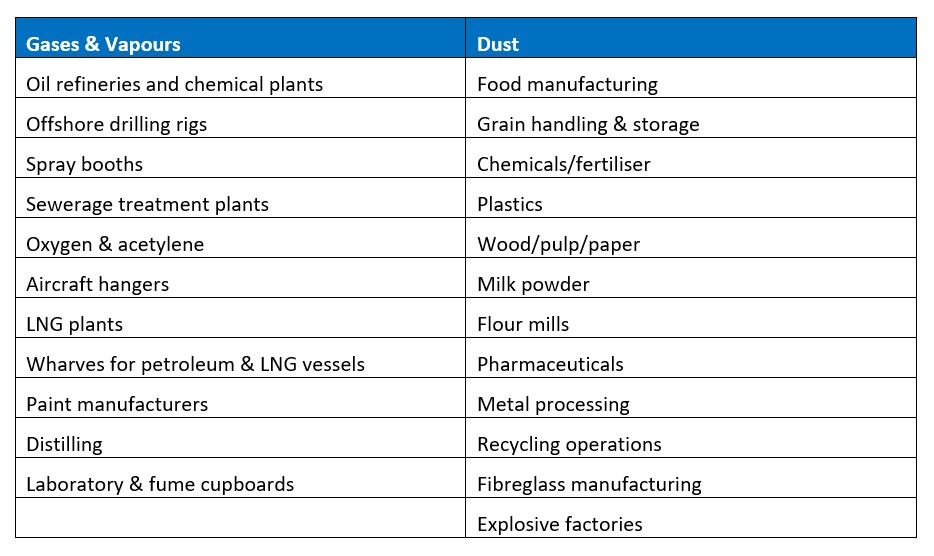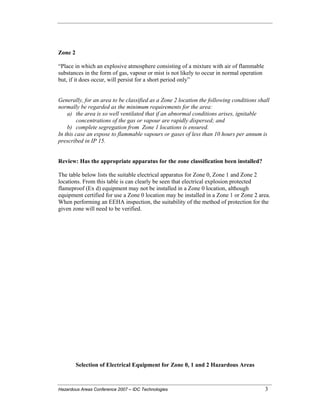Some Known Factual Statements About Roar Solutions
Some Known Factual Statements About Roar Solutions
Blog Article
Indicators on Roar Solutions You Should Know
Table of ContentsThe Only Guide for Roar SolutionsThe Basic Principles Of Roar Solutions Not known Details About Roar Solutions
In such an atmosphere a fire or explosion is possible when 3 fundamental conditions are satisfied. This is often referred to as the "dangerous area" or "burning" triangle. In order to secure installments from a potential explosion a technique of evaluating and identifying a potentially hazardous area is required. The purpose of this is to make certain the proper option and installment of equipment to inevitably avoid an explosion and to ensure safety of life.
(https://www.quora.com/profile/Roarsolutions)
No tools needs to be set up where the surface area temperature of the tools is higher than the ignition temperature of the offered risk. Below are some usual dirt unsafe and their minimal ignition temperature level. Coal Dirt 380C 225C Polythene 420C (thaws) Methyl Cellulose 420C 320C Starch 460C 435C Flour 490C 340C Sugar 490C 460C Grain Dirt 510C 300C Phenolic Resin 530C > 450C Aluminium 590C > 450C PVC 700C > 450C Soot 810C 570C The possibility of the risk existing in a focus high enough to create an ignition will certainly vary from place to location.
In order to classify this danger a setup is split right into locations of risk depending upon the amount of time the hazardous is present. These locations are described as Areas. For gases and vapours and dirts and fibers there are 3 zones. Zone 0 Area 20 A hazardous atmosphere is highly likely to be existing and might be present for lengthy periods of time (> 1000 hours per year) or perhaps continuously Zone 1 Zone 21 A harmful environment is possible yet unlikely to be existing for extended periods of time (> 10 450 C [842 F] A category of T6 suggests the minimum ignition temperature is > 85 C [185 F] Hazardous location electrical equipment perhaps developed for usage in greater ambient temperature levels. This would suggested on the rating plate e.g. EExe II C T3 Ta + 60C( This indicates at 60C ambient T3 will certainly not be exceeded) T1 T1, T2, T3, T4, T5, T6 T2 T2, T3, T4, T5, T6 T3 T3, T4, T5, T6 T4 T4, T5, T6 T5 T5, T6 T6 T6 A T Class ranking of T1 means the maximum surface area temperature generated by the tool at 40 C is 450 C. Presuming the associated T Class and Temperature ranking for the equipment are suitable for the location, you can constantly make use of an instrument with an extra rigid Division rating than required for the location. There isn't a clear response to this question. It actually does depend on the kind of equipment and what repair services require to be brought out. Tools with specific test treatments that can't be done in the field in order to achieve/maintain 3rd party score. Have to come back to the manufacturing facility if it is before the tools's service. Field Fixing By Authorised Employee: Complicated testing might not be called for however particular procedures might require to be complied with in order for the tools to keep its 3rd party rating. Authorised workers should be employed to carry out the job properly Fixing must be a like for like substitute. New component should be considered as a direct replacement requiring no unique screening of the equipment after the repair is full. Each tool with a dangerous score need to be examined separately. These are described at a high level listed below, but for even more in-depth info, please refer straight to the guidelines.
The 9-Second Trick For Roar Solutions
The tools register is a thorough database of tools documents that consists of a minimum collection of fields to identify each thing's place, technological criteria, Ex category, age, and environmental information. The proportion of Detailed to Shut evaluations will be determined by the Equipment Threat, which is assessed based on ignition danger (the likelihood of a source of ignition versus the chance of a combustible atmosphere )and the dangerous location category
( Zone 0, 1, or 2). Carrying out a robust Risk-Based Inspection( RBI )technique is crucial for guaranteeing conformity and security in managing Electrical Tools in Hazardous Locations( EEHA).
Not known Factual Statements About Roar Solutions

In terms of explosive threat, an unsafe area is an atmosphere in which an eruptive ambience is present (or may be expected to be present) in quantities that call for special precautions for the construction, setup and use devices. eeha. In this short article we check out the obstacles encountered in the work environment, the threat control procedures, and the needed competencies to work securely
It is a consequence of contemporary life that we make, store or handle a variety of click for more gases or fluids that are considered combustible, and a variety of dirts that are regarded combustible. These compounds can, in specific problems, develop eruptive ambiences and these can have major and tragic effects. The majority of us know with the fire triangular eliminate any kind of among the three aspects and the fire can not take place, yet what does this mean in the context of unsafe areas? When breaking this down right into its simplest terms it is essentially: a mix of a particular quantity of release or leakage of a certain substance or material, combining with ambient oxygen, and the existence of a source of ignition.
In most circumstances, we can do little regarding the degrees of oxygen in the air, however we can have substantial impact on resources of ignition, for instance electric tools. Unsafe areas are recorded on the hazardous area classification illustration and are recognized on-site by the triangular "EX LOVER" indicator. Here, amongst other key information, areas are divided right into 3 kinds depending upon the risk, the likelihood and duration that an eruptive atmosphere will exist; Zone 0 or 20 is regarded one of the most harmful and Area 2 or 22 is regarded the least.
Report this page